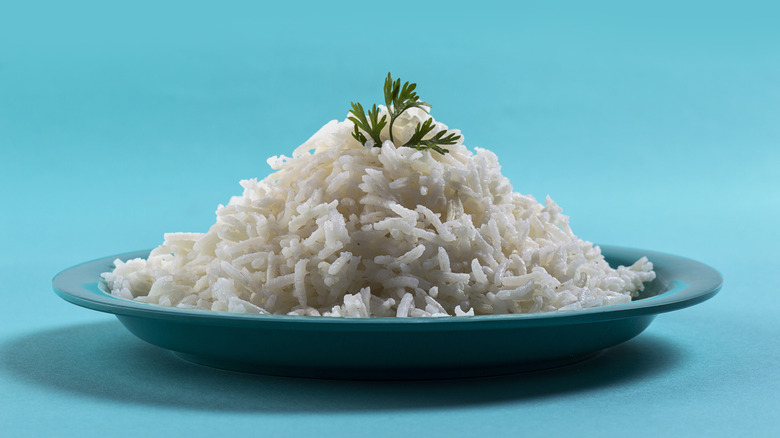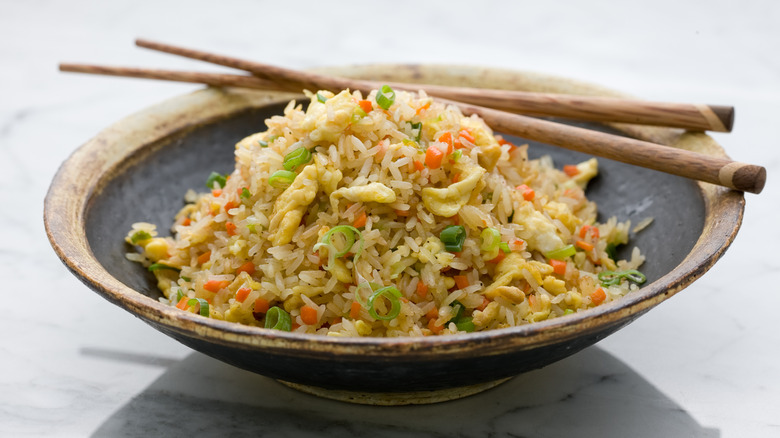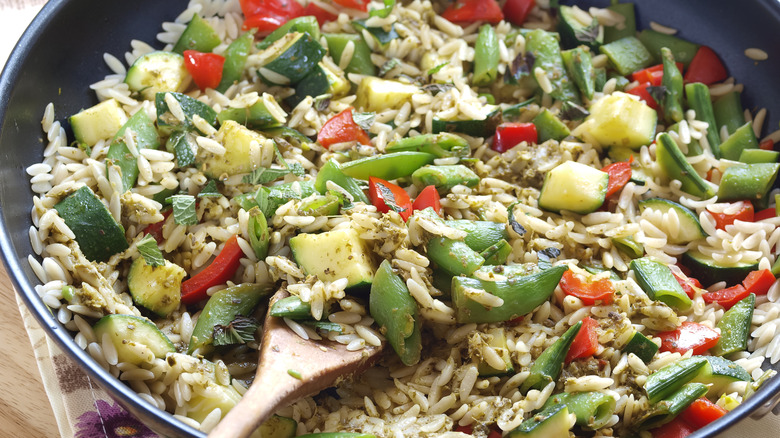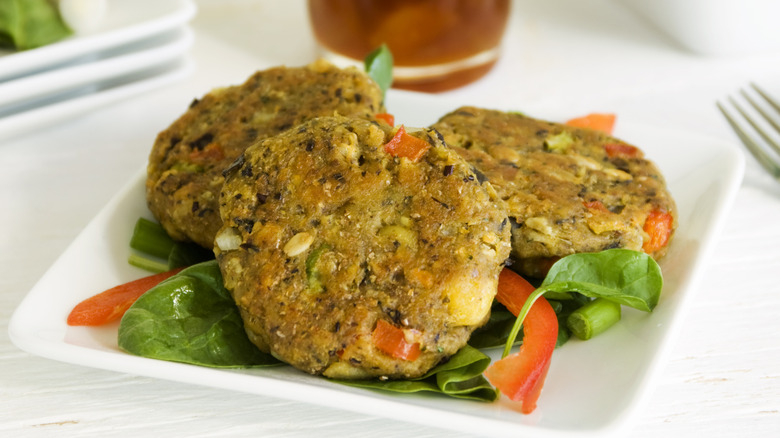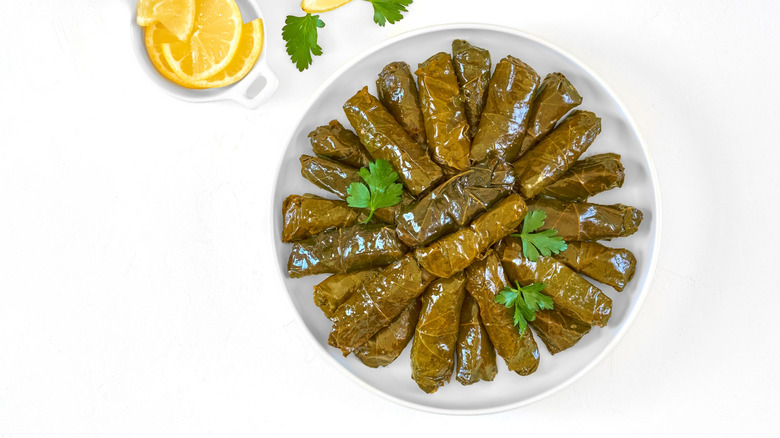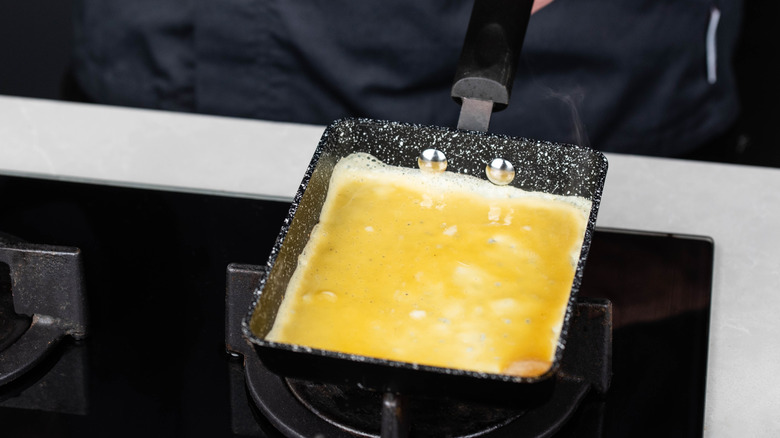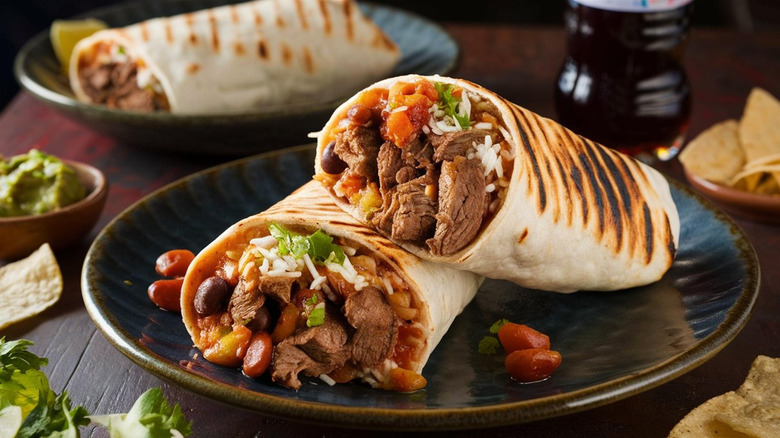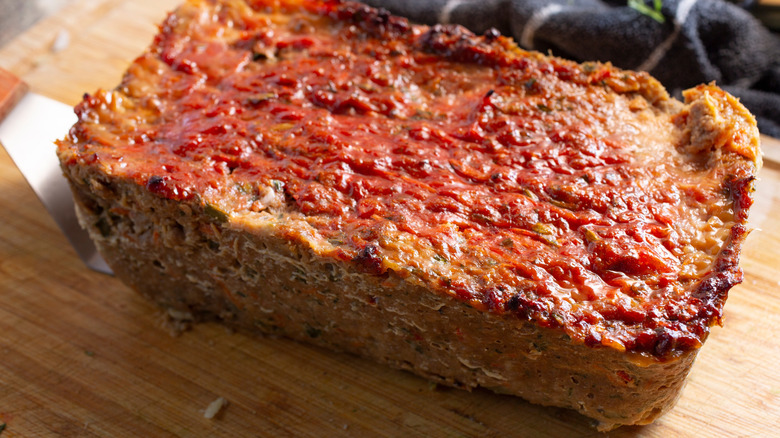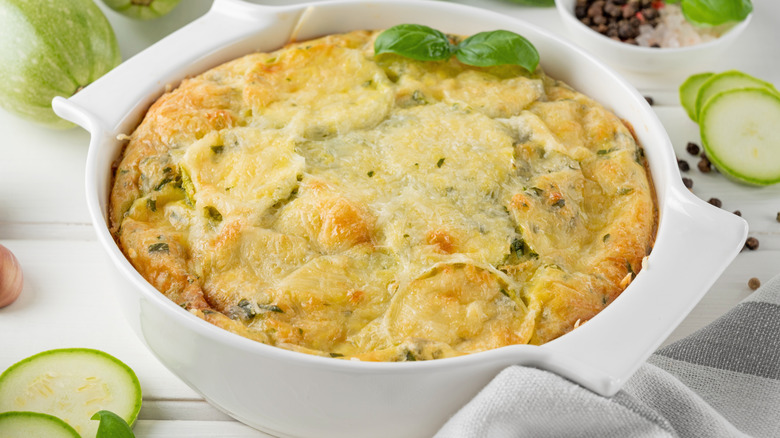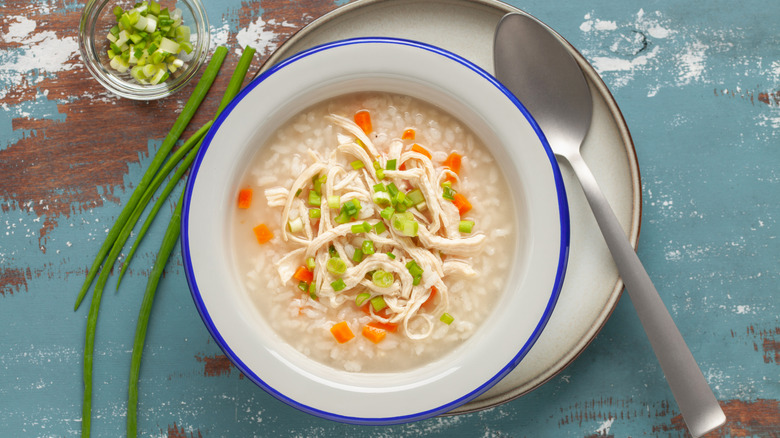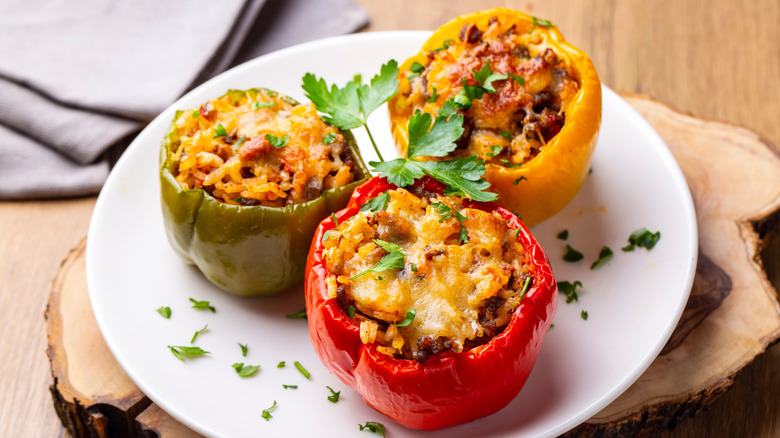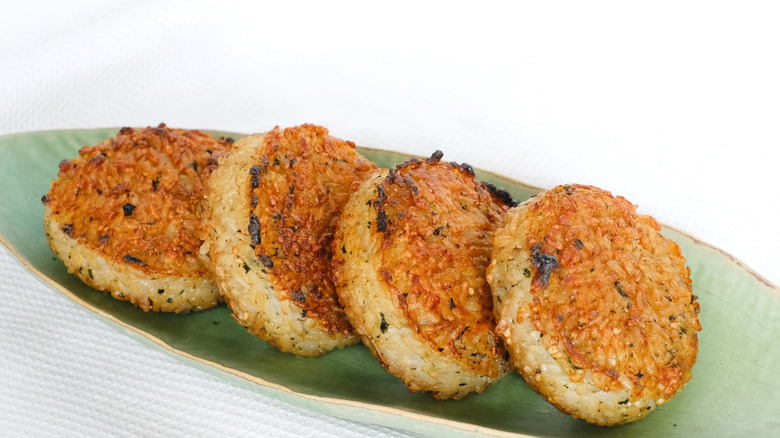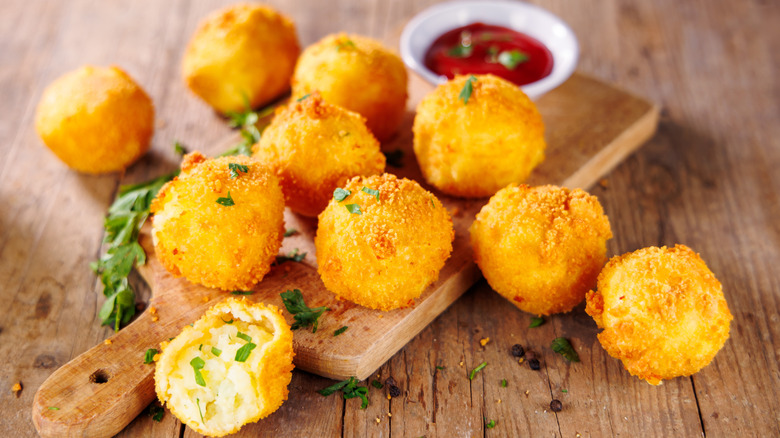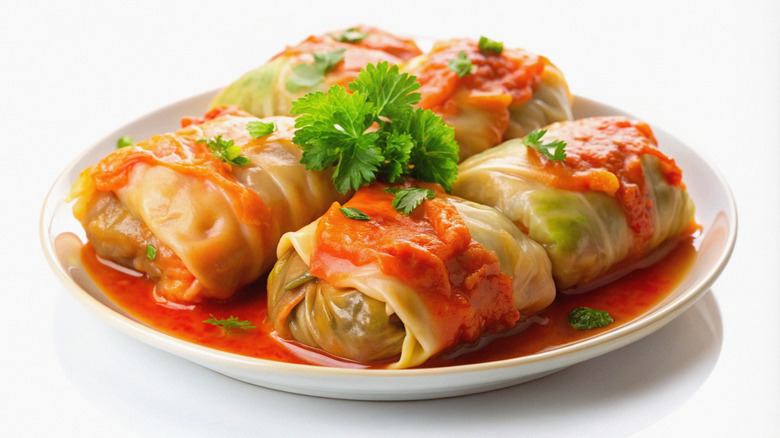The Absolute Best Ways To Upgrade Leftover Rice
It's easy to cook too much rice because it expands a great deal in the pan. But, how can you repurpose leftover rice beyond simply reheating it and eating it as a side for another day? Anyone hoping to get more creative will be pleased to know there are many ways to use leftover rice. From obvious choices like soups and fried rice to less common choices, such as veggie burgers and cabbage rolls, there are plenty of tasty options when it comes to using up that rice.
For those worried about eating leftover rice at all, you needn't be, as long as you're cautious. It's true that eating leftover rice can be dangerous, but only if you leave it in conditions that let bacteria grow. Follow proper food safety rules, and there shouldn't be an issue. That means you should cool any leftovers quickly and put them straight in the fridge once they're no longer warm. When you eat leftovers, make sure to reheat the rice thoroughly to kill any bacteria that may have grown. And, only reheat it once. If you reheat it and you still have leftovers, these will need to be thrown away.
So, now that you know that carefully reusing leftover rice isn't going to make you sick, you might want some inspiration. Using rice that's already in your fridge or freezer not only prevents food waste, but it also makes it quicker and easier to get dinner on the table.
Whip up some fried rice
Fried rice is perhaps the most common way to use leftover rice, giving it a new lease of life and tons of extra flavor. It's a popular option for a reason: This dish is actually best made with leftover rice because the texture is better than when you make it with freshly cooked rice. So, when you have plenty of grains remaining from last night's dinner, fried rice is calling — and you're going to want to answer.
An easy egg fried rice recipe involves scrambling a few eggs and adding leftover rice when the eggs have formed curd but are still partially liquid. Then, you add other ingredients, such as oil, soy sauce, and green onions. However, you can get way more creative when deciding what to add. You can toss in meat, tofu, mushrooms, peas, bell peppers, broccoli — whatever veggies and proteins take your fancy. It's a great way to use up what you already have in your fridge. Just be aware that some ingredients work better than others. Pak choi (aka bok choy) or edamame beans will be a better fit than rutabaga or grilled eggplant, for instance.
Soy sauce is perhaps the most common addition for flavor, but you don't have to stop there. Toasted sesame oil brings a nutty flavor, while MSG and mushroom seasoning powder from an Asian grocery store deliver umami notes and accentuate other flavors. For those who like it spicy, chili crisp is a great addition.
Use leftover rice in a warm salad
When people talk about salads, something raw, fresh, and crisp usually comes to mind. You might be thinking about iceberg lettuce and cucumber cool from the fridge. But, you can make a warm salad with leftover grains — and that includes rice.
You'll need to reheat the rice for your warm salad. You can do this in the microwave or in a pan with a little oil. Microwaving it will give you a softer texture, while frying it in a pan makes it chewier. You can even make it a little crispy if you want to. Whichever way you go, the rice makes a warming, filling base for your salad.
But, what else could you put in a warm salad and how should you heat the ingredients? The beauty of rice is that it works with many ingredients, but this can leave you paralyzed by all the possible choices. The key is not to overthink it. All kinds of veggies work here, and we'd recommend roasting them rather than steaming or sautéing. This gives them a rich, caramelized flavor and is a hands-off process. Just stick them in the oven and wait. Consider using what's in season — so things like beets, carrots, and squash in fall and winter, or beans, tomatoes, and zucchini in summer.
Turn leftover rice into veggie burgers
You can use leftover rice in homemade veggie burgers. Most meat-free burgers today are realistic meat replacements, like Beyond Burgers, but what about a good old fashioned hippy meatless burger with real vegetables? In these kinds of recipes, rice acts as a natural binder, helping hold all your ingredients together while adding a pleasantly chewy texture to your burger. Plus, the rice makes your veggie burgers more filling and substantial.
When you add cooked rice to your veggie burger mix, its natural starchiness helps the patties hold their shape during cooking. This means your burgers are less likely to fall apart on the grill or in the pan. Mix the rice with your other veggie burger ingredients like beans, mushrooms, or grated vegetables. The rice will absorb flavors from seasonings and help distribute them throughout the patty.
White and brown rice both work well in veggie burgers. Brown rice adds extra fiber and a slightly nutty flavor, while white rice blends more seamlessly with other ingredients. Finish these burgers off with your choice of herbs and spices to season them. Once the mixture is complete, form it into patties, and either pan fry them or bake them. Serve them with all the sauces and trimmings you'd use for regular burgers.
Stuff leftover rice in grape leaves
Stuffed grape leaves are usually known as dolma in Greek cuisine and warak enab in Middle Eastern cuisine. They consist of rice mixed with herbs and spices and wrapped inside a grape leaf. Since you cook the filling and leaves together after stuffing them, it's fine to use leftover rice as it will be reheated to a safe temperature.
There are many variations on stuffed grape leaves, so you'll need to find a recipe to work from if you don't already have one. Then, just avoid the step for cooking the rice and use your leftovers instead. It cuts down the amount of time this dish takes to make, which is great because all the wrapping of the filling into the leaves can take a while.
If you're wondering where to find the grape leaves to make this dish, try a local Middle Eastern grocery store, if you have one. Alternatively, you may find them in a large supermarket with a significant Mediterranean or Middle Eastern section.
Do a breakfast version of fried rice
Okay, we've talked about fried rice already, but bear with us a moment. What about fried rice but for breakfast? This might not seem to work at first because rice isn't a common breakfast ingredient in the U.S. However, there are plenty of countries in which rice is a staple at breakfast, so we can draw inspiration from these.
Rachel Ray has a favorite fried rice breakfast dish. It involves making a thin omelet, rolling it up, and then shredding it. Set it aside. Then, fry up Chinese sausage and bacon, adding leftover rice, seasonings like soy sauce and Shaoxing wine, and leeks. Gently stir in the aforementioned omelet last. The resulting dish is a take on the American classic of bacon, sausage, and eggs but with a Chinese twist. You could also make a vegetarian version of this by substituting the bacon and sausage for veggies.
This makes for a hearty breakfast or brunch. It's a great choice if you're looking to expand your horizons with the first meal of the day. It's also for those times when you want to make something impressive for brunch during the weekend. If you were ever skeptical, you'll soon change your tune about eating rice for breakfast.
Throw together some burritos
If you love rice in your burritos, using leftovers is perfect. Usually, you'd need to wait for the rice to cook before you could assemble your burritos. But, when you already have some in the fridge ready to go, you can make yourself a tasty meal that comes together quickly.
Usually, you might add rice as a distinct layer in your burrito. However, when you're making one using leftover rice, it's easier to mix it in with the other ingredients. Start by sautéing whatever veggies, beans, and other proteins you want in your burrito. Then, when they're almost ready, add the rice and keep sautéing for another 4 to 5 minutes, until the rice is piping hot. Then, you just need to throw the filling in your burrito and wrap it up.
What we love about burritos is that even if you keep the bulk of the fillings the same each time you cook them, it's easy to make them your own with your choice of fillings and toppings. For instance, a burrito with pico de gallo and guacamole is going to taste quite different from one with salsa verde, sour cream, and hot sauce. You can use a combination of salsas, hot sauces, creamy dressings, cheeses, and anything else that takes your fancy to personalize your burrito.
Put leftover rice in a meatless meatloaf
A meatless meatloaf might sound like an oxymoron, but it can be surprisingly delicious when you get it right. Using leftover rice in a veggie meatloaf is not only a great way to use the rice up, but it also tastes good and adds carbohydrates and starch to make the dish more filling. Yes, these kinds of veggie-heavy loaves absolutely hark back to '80s and '90s vegetarianism, but in a world full of mock meats, sometimes that's exactly what you want.
Rice makes up just one part of these loaves. There are countless recipes out there, but they usually also contain mashed beans or lentils, cooked veggies that have been pulsed in a food processor, or a combination of the two. Using aromatics, such as onions and garlic, makes it more tasty. Mix in your choice of herbs and spices, and you've got a tasty dinner. When slightly pulsed in a food processor, the starchy rice can help bind all the ingredients together too.
Bake a summer squash casserole
This cheesy summer squash casserole recipe is a great way to use leftover rice. It feels way more fancy than most people would expect for a dish you're only making to finish up your day-old rice. Plus, if you grow your own vegetables, you probably have a glut of summer squash for a couple of months a year that you're always desperate to use.
This dish involves sautéing onions, garlic, and summer squash — such as pattypan squash or zucchini — and adding leftover rice. Then stir this into a creamy, cheesy sauce, and bake it in the oven until it's hot and bubbly. It makes a great side dish or a slight main with a salad.
Of course, you don't have to stop with summer squash for this casserole. You could adjust it to use whatever veggies you have on hand. It's great with winter squash, broccoli, cauliflower, or green beans. You can adjust it to use seasonal veggies or anything else you have in the fridge that you need to use up.
Toss leftover rice in a soup
Leftover rice can instantly turn a bowl of soup from a starter into a more filling meal. This simple addition works with almost any soup, whether you've made it from scratch or picked up a can from the store. Adding rice bulks up your soup and makes it into a perfect fall or winter dinner.
You can add cold leftover rice directly to soup as you're heating it or in the last 5 minutes of cooking soup that you're making from scratch. It will warm up quickly, absorbing the soup's flavors as it heats. White rice works well in nearly every type of soup. Try it in a classic vegetable soup or in harira instead of noodles. Brown rice adds nutty flavor and chewy texture, and even wild rice blends can work, though their stronger flavor might overwhelm delicate broths.
Most store-bought soups benefit from added rice. A can of basic soup becomes more interesting and substantial when you throw these grains into the mix. The rice helps stretch a single can into a meal that feeds two people. Plus, it adds texture and body to thin commercial broths. But, of course, you can add it to homemade soup, too. Either keep your soup chunky or add the rice after blending. Don't blend the rice into the soup, though, because it will turn weirdly starchy.
Stuff some peppers with leftover rice
Stuffed peppers don't get a lot of love these days. They were hugely popular in the '80s and '90s but became a bit of a copout of a vegetarian option, often the only one on a menu. However, a well-executed stuffed pepper is actually delicious — and this dish is a great way to use up leftover rice. Adding rice brings texture to the filling, helps it hold together, and means it's hearty enough to serve as a main meal.
This recipe for 30-minute stuffed peppers makes use of leftover rice. But, plenty of other recipes do too. Stuffed peppers are also easy to make without following an exact recipe. You can combine rice with sautéed veggies, lentils, herbs, spices, and a sauce of your choice, mixing and matching ingredients to suit your preferences or use up ingredients that you already have.
Once you've prepared your filling, you just have to stuff it inside your peppers, top them off with some cheese, and stick them in the oven. Once they're done, the pepper will be soft and tasty, and the flavors in the filling will have melded. The resulting dish is way yummier than the sum of its parts. You might have made it from humble ingredients, but it tastes amazing.
Make griddled rice cakes
Sometimes the simplest recipes are the most delicious. Griddled rice cakes aren't much more than rice and a little salt, griddled or pan-fried. However, they're extremely tasty. They're an easy lunch or a great side for katsu curry or another saucy stew-like meal.
This dish should ideally be made with leftover sushi rice or another sticky short grain rice. That's because sticky sushi rice is easy to form into patties, with just around a tablespoon of flour needed per 2 cups of rice. However, you can use other types of rice if that's what you have. You'll just need to use an egg and some extra flour as a binder. This will help the rice reach a consistency that makes it possible to shape and form it into patties.
Once you've got the patties formed, heat a few tablespoons of a neutral oil in a skillet and cook the rice cakes for about 5 minutes on each side. A golden crust will form when the cakes are ready. Don't rush them because the crisp exterior and soft interior are a big part of what makes them so good. If you're eating them on their own, they're great sprinkled with furikake seasoning and dipped in soy sauce.
Fry some arancini balls
Making arancini is the perfect way to make your leftover rice work for you. While traditional arancini uses leftover risotto, you can make tasty versions with any type of leftover rice. Risotto works best because its creamy, starchy texture helps the balls hold together, but don't let that stop you from experimenting.
To make arancini, start with cold leftover rice. If you're using plain rice instead of risotto, mix in some grated parmesan cheese and a beaten egg to help bind it together. Take a handful of the rice mixture, and form it into a ball, wrapping it around your choice of filling. Mozzarella or other cheese is a common filling option, but the choice is yours. Next, start breading. Roll each ball in flour, then dip it in beaten egg, and finally coat it in breadcrumbs. Fine breadcrumbs work best here, rather than chunkier versions, such as panko. Finally, deep-fry the arancini balls until they're golden brown and heated through. The outside should be crunchy, while the inside stays creamy.
Serve your arancini balls hot, perhaps with marinara or Alfredo sauce for dipping. They make great appetizers or a main course when paired with a salad. Once you master the basic technique, you can play around with different fillings and seasonings to create your own signature version.
Put leftover rice in cabbage rolls
Leftover rice makes excellent stuffed cabbage rolls. The rice serves as the perfect base for the filling, adding bulk and helping to bind the other ingredients. The starch and carbohydrates also make this into a satisfyingly hearty meal.
To make the filling, mix leftover rice with your choice of protein and seasonings. Ground meat works well, or you can make vegetarian versions with crumbled tempeh, finely chopped mushrooms, or seasoned lentils. Add sautéed onions, garlic, and your favorite herbs and spices to enhance the flavor. You can use most varieties of cabbage — traditional green cabbage, tender napa cabbage, or crinkly savoy cabbage. Each type brings its own texture and flavor to the dish.
Place a spoonful of filling near the stem end of each prepared leaf. Fold in the sides and roll the leaf around the filling, similar to wrapping a burrito. The rolls should be snug but not too tight. You can cook your cabbage rolls in tomato sauce, broth, or a combination of both. Some cooks prefer a paprika-spiced sauce, while others opt for a simpler tomato base. Simmer the rolls gently until they're heated through and the cabbage is tender. While there might be quite a few steps to this dish, using leftover rice makes it quicker and easier.
